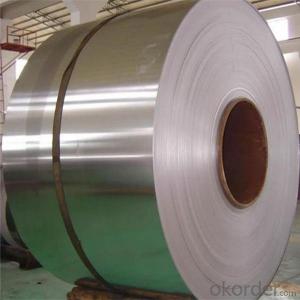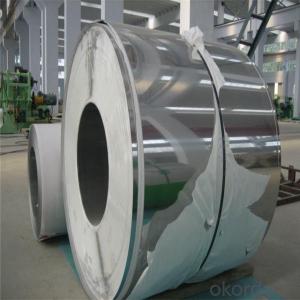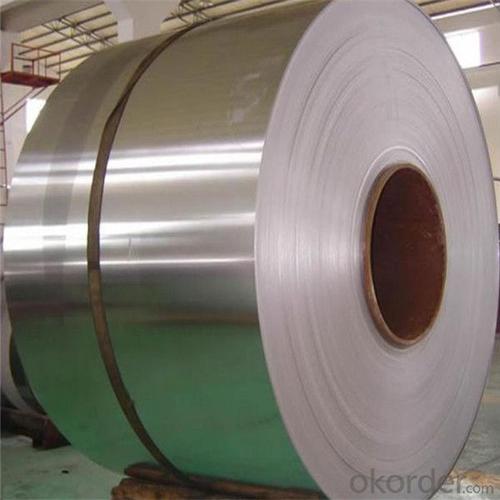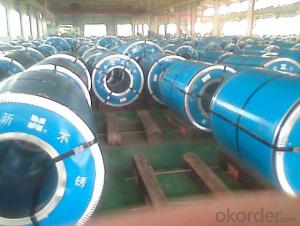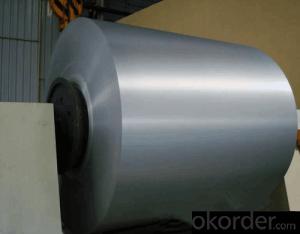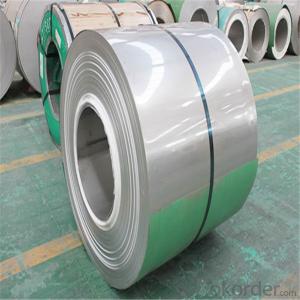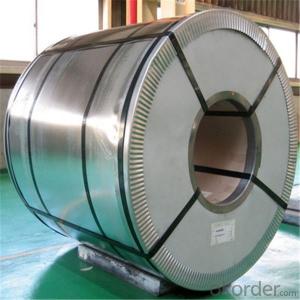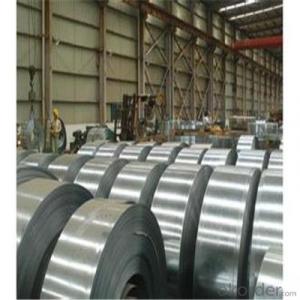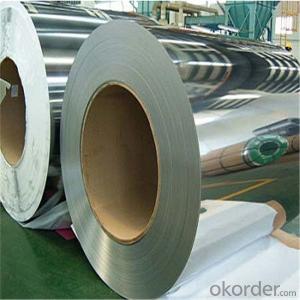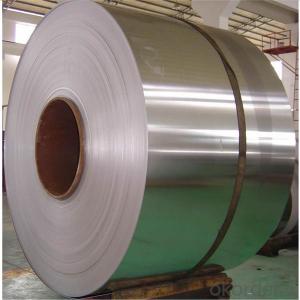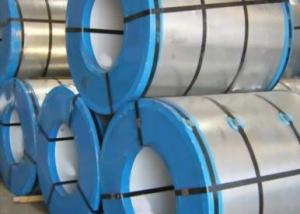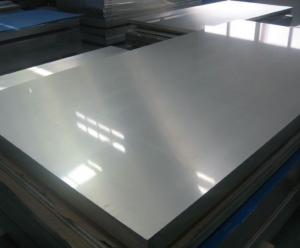Stainless Steel Coil Price Per KG in China
- Loading Port:
- Shanghai
- Payment Terms:
- TT OR LC
- Min Order Qty:
- 4 m.t.
- Supply Capability:
- 10000 m.t./month
OKorder Service Pledge
OKorder Financial Service
You Might Also Like
Specification
Detailed Product Description
Product Name: stainless steel coil
Features:
1) Grade: 430, 301,304, 316L, 201, 202, 410, 304
2) Specs: Thickness 0.3-3mm Width 20~ 480mm x C
We also produce other specification according to customer's requirements.
3) Executed Standard: JIS, ASTM, GB
4) Packing: plastic bag, weaving bag, wooden case or according to the customers
5) Applications: construction, decoration, machinery furniture, automobile, fluid transportation, Industry instrument, agriculture, kitchenware
6) Cold Rolling Thick:0.3mm-3.0mm Width:365-480
Specifications
Cold Rolled Stainless Steel Mill/Slit Coil
1. Grade: 200 & 300 series
200 seriers: 201,202, J4
300 seriers: 301, 304, 304L, 321, 316L, 309, 310S
2. Standard: JIS, ASTM, AISI, GB, DIN, EN, we usually use ASTM and GB Standard
3. Thickness: 0.14mm-3.0mm
4. Width: 10-700mm
5. Surface: 2B finished, BA finished
6. Hardness: soft, 1/4H, 1/2H, FH
7. Thickness Tolerance: +/-0.02mm
8. Width Tolerance: +/-10mm(mill edge)
Hot Rolled Stainless Steel Coil
1. Grade: 200 & 300 & 400 series
200 seriers: 201,202
300 seriers: 301, 304, 304L, 316L, 309, 310S,321
400 seriers: 410, 410S, 409L,430
2. Standard: JIS, ASTM, AISI, GB, DIN, EN, we usually use ASTM and GB Standard
3. Thickness: 2.4mm-6.0mm
200 series: 2.4mm-6.0mm
300 series: 2.4mm-6.0mm
400 series: 2.4mm-6.0mm
4. Width: 405mm-700mm
5. Surface: No1 finished, mill edge
6. Hardness: soft
7. Thickness Tolerance: +/-0.1mm
8. Width Tolerance: +/-10mm
9. Mills: Quanxing, Xingda
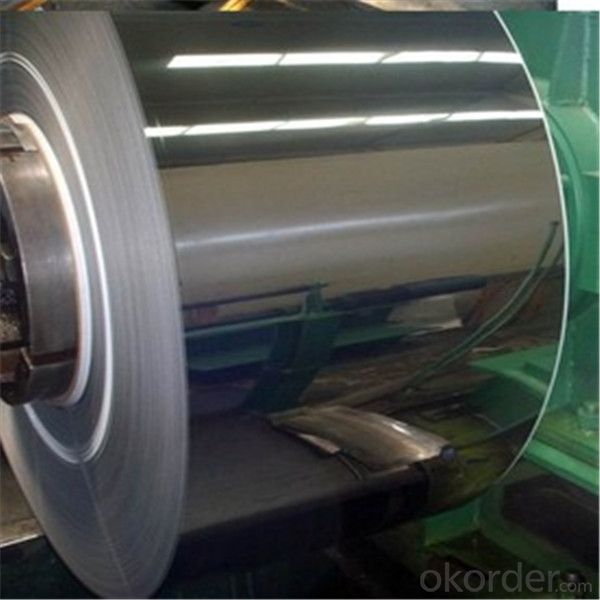
Producing Line of Stainless Steel Coil
1. 750mm 6-rolling mill (CR)
2. 850mm 2-rolling mill (HR)
5. 8 sets of bright annealing producing line (CR)
3. 8 sets of pickling and annealing line (HR)
6. 2 sets tension levelers
7. 2 sets degreasing cleaning lines
8. 4 sets slit cutting machine
9. 2 sets cutting plate machine
10. 1 set mulch applicator with PVC
11. 1 set wrapping machine
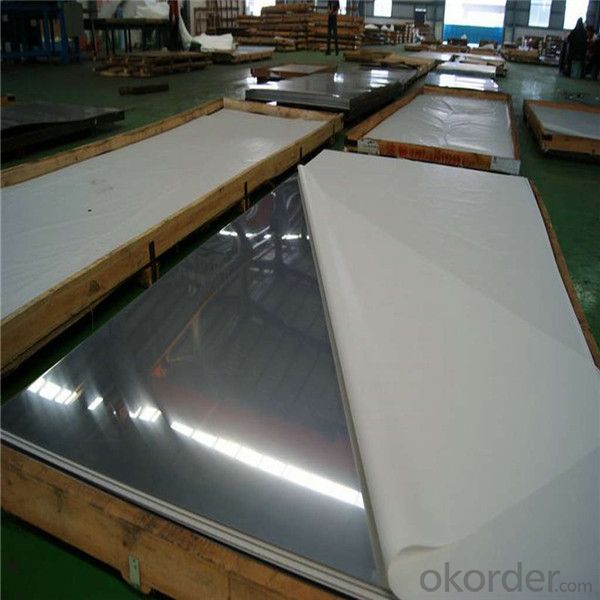
Applications
1.Automotive: Automotive trim and molding/Difficult-to-form exhaust-system components, tubular manifolds, mufflers/Exhaust manifold and other exhaust-system components, catalytic converter shells, clamps
2.Construction: Gutters and downspouts, roofing, siding
3.Kitchenware: Cooking utensils, dishwashers, ovens, range hoods, refrigerators, skewers
4.Chemical processing: Oil refinery equipment, oil burner and heater parts
5.Appliances: Hot water tanks, residential furnaces
6.Power generation: Heat Exchanger tubing
7.Farming:Dry fertilizer spreaders/Farm animal pens
- Q: What are the differences between hot-rolled and cold-rolled 111 stainless steel strips?
- The main differences between hot-rolled and cold-rolled 111 stainless steel strips lie in their production processes and resulting characteristics. Hot-rolled stainless steel strips are produced by heating the stainless steel to a high temperature and then passing it through rollers to achieve the desired thickness. This process provides a more malleable and ductile material, allowing for easier shaping and forming. The hot-rolled strips have a rougher surface finish and a scaled oxide layer, which can be removed through additional processing if desired. They also tend to have a larger grain structure, resulting in a less precise and more variable dimensional tolerance. On the other hand, cold-rolled stainless steel strips are produced by further processing the hot-rolled strips through a cold reduction process. This involves passing the hot-rolled strips through a series of rollers at room temperature, which results in a smoother surface finish and a more precise dimensional tolerance. The cold-rolled strips have a finer grain structure and a more uniform thickness, making them ideal for applications where precision and consistency are required. In terms of mechanical properties, hot-rolled stainless steel strips generally exhibit higher yield and tensile strengths compared to cold-rolled strips. This is due to the strain hardening that occurs during the hot-rolling process. However, cold-rolled strips tend to have better surface quality and improved flatness due to the additional processing steps. In summary, hot-rolled stainless steel strips are more malleable and have a rougher surface finish, while cold-rolled strips offer better dimensional precision, surface quality, and flatness. The choice between the two depends on the specific requirements of the application, such as the need for shaping, precision, or surface aesthetics.
- Q: Are stainless steel strips suitable for water treatment applications?
- Yes, stainless steel strips are suitable for water treatment applications. Stainless steel is highly resistant to corrosion and can withstand exposure to water and various chemicals commonly used in water treatment processes. It has excellent strength and durability, making it suitable for use in water treatment equipment such as filters, screens, tanks, and pipes. Additionally, stainless steel is hygienic and easy to clean, which is crucial in maintaining water quality. Its resistance to bacterial growth and ability to withstand high temperatures also make it a reliable choice for water treatment applications.
- Q: Are stainless steel strips suitable for architectural mesh?
- Yes, stainless steel strips are suitable for architectural mesh. Stainless steel is a popular choice for architectural applications due to its durability, strength, and corrosion resistance. Stainless steel strips can be formed into various patterns and designs, making them ideal for creating decorative and functional architectural mesh. Additionally, stainless steel is low maintenance and can withstand harsh environmental conditions, making it a reliable choice for long-lasting architectural installations.
- Q: What is the lifespan of stainless steel strips?
- The lifespan of stainless steel strips can vary depending on various factors such as the grade of stainless steel, the environment in which they are used, the maintenance practices followed, and the specific application they are being used for. Generally, stainless steel is known for its corrosion resistance and durability, which contributes to its long lifespan compared to other materials. In most cases, stainless steel strips can last for several decades or even longer. The high corrosion resistance of stainless steel helps to prevent rust and degradation, which can significantly extend its lifespan. Additionally, stainless steel is resistant to extreme temperatures, chemicals, and physical wear and tear, making it suitable for a wide range of applications. However, it is essential to note that the lifespan of stainless steel strips can be influenced by external factors. For instance, if the stainless steel strips are exposed to highly corrosive environments, such as saltwater or acidic conditions, their lifespan may be reduced. In such cases, regular maintenance and proper cleaning can help to prolong their lifespan. Furthermore, the grade of stainless steel used in the strips can also impact their lifespan. Certain grades of stainless steel, such as 316 or 2205, are specifically designed to withstand harsh environments and have enhanced corrosion resistance compared to lower grades. To maximize the lifespan of stainless steel strips, it is crucial to follow proper installation and maintenance practices. This may include regular cleaning, application of protective coatings, and avoiding contact with incompatible materials. In conclusion, stainless steel strips have a long lifespan due to their inherent corrosion resistance and durability. However, the actual lifespan can vary based on factors such as grade, environment, maintenance, and application. By selecting the appropriate grade, following proper maintenance practices, and considering the specific application requirements, stainless steel strips can provide exceptional longevity and performance.
- Q: What are the different types of edge finishes for stainless steel strips?
- Stainless steel strips can be given various edge finishes to improve both their appearance and functionality. Among these options is the straight edge finish, a simple straight cut along the strip's edge. This is commonly utilized in industrial settings where appearance is not a priority. Another frequently used edge finish is the deburred edge, which entails removing any sharp or jagged edges from the strip. This is crucial for safety purposes, as it prevents accidental cuts or injuries. For a more ornamental effect, the rounded edge finish is employed. This involves rounding off the edges of the strip to create a smooth and polished appearance. Often seen in architectural or decorative applications, it imparts a refined and elegant look to the stainless steel strip. Another popular choice is the beveled edge finish, where the edges of the strip are cut at an angle to create a chamfered or sloped edge. This is commonly employed when a seamless transition is required, such as when joining two strips together. Furthermore, there are edge finishes that involve applying a coating or treatment to the edge of the stainless steel strip. This can include the application of a protective film to prevent corrosion or the use of a colored coating for aesthetic purposes. Ultimately, the selection of an edge finish for stainless steel strips depends on the specific requirements of the application, whether it be functionality, safety, or aesthetics.
- Q: What are the factors affecting the thermal expansion of 111 stainless steel strips?
- There are several factors that can affect the thermal expansion of 111 stainless steel strips. 1. Composition: The composition of the stainless steel, including the presence of alloying elements such as nickel and chromium, can impact its thermal expansion behavior. Different compositions can result in different rates of expansion when subjected to temperature changes. 2. Temperature range: The temperature range to which the stainless steel strips are exposed can significantly affect their thermal expansion. Higher temperatures generally cause materials to expand more, while lower temperatures can lead to contraction. The specific temperature range in which the strips are used or exposed will determine their thermal expansion characteristics. 3. Heat treatment: The heat treatment process applied to the stainless steel strips can also influence their thermal expansion. Various heat treatment methods, such as annealing or quenching, can alter the microstructure and crystal lattice of the steel, affecting its thermal expansion properties. 4. Grain size: The grain size of the stainless steel can impact its thermal expansion behavior. Smaller grain sizes generally result in lower thermal expansion coefficients, while larger grain sizes can lead to higher coefficients. The grain size can be influenced by factors such as the manufacturing process and heat treatment. 5. Surface finish: The surface finish of the stainless steel strips can affect their thermal expansion as well. Different surface finishes, such as polished or rough surfaces, can alter the thermal expansion characteristics by influencing the ability of the material to transfer heat. 6. Presence of impurities: The presence of impurities or foreign elements in the stainless steel can also affect its thermal expansion behavior. Impurities can disrupt the crystal lattice structure and introduce defects, which can impact the material's thermal expansion properties. 7. Mechanical stress: The presence of mechanical stress, either applied externally or generated internally due to manufacturing processes, can influence the thermal expansion behavior of the stainless steel strips. Mechanical stress can cause changes in the material's crystal structure and affect its ability to expand or contract uniformly. It is important to consider these factors when designing and selecting stainless steel strips for specific applications where thermal expansion characteristics are critical. By understanding and accounting for these factors, engineers can ensure that the stainless steel strips perform optimally under varying temperature conditions.
- Q: Can 111 stainless steel strips be formed into seamless tubes?
- Indeed, it is possible to form seamless tubes from 111 stainless steel strips. Typically, the stainless steel strips undergo cold rolling, resulting in a circular shape, after which the edges are skillfully welded to achieve a seamless tube. This technique finds widespread application in the manufacturing industry, catering to diverse needs such as plumbing, automotive, and industrial purposes.
- Q: Are stainless steel strips suitable for heat exchanger tubes?
- Yes, stainless steel strips are suitable for heat exchanger tubes. Stainless steel is known for its excellent corrosion resistance and heat resistance properties, making it an ideal material for heat exchanger applications. Stainless steel strips offer high strength, durability, and resistance to high temperatures, making them suitable for use in heat exchanger tubes. Additionally, stainless steel is easy to clean and maintain, ensuring the long-term performance and reliability of the heat exchanger.
- Q: Can stainless steel strips be used in the production of medical implants?
- Indeed, medical implants can be produced using stainless steel strips. The medical domain frequently employs stainless steel owing to its remarkable resistance to corrosion, its strength, and its biocompatibility. Surgeons commonly utilize this material for surgical implants, including bone plates, screws, and dental implants. By shaping, cutting, and forming stainless steel strips, diverse components for implants can be obtained, ensuring the indispensable strength and durability needed for medical purposes. Furthermore, stainless steel facilitates sterilization, making it a fitting choice for medical implants where cleanliness and hygiene play a critical role.
- Q: Can stainless steel strips be used for knife blades?
- Yes, stainless steel strips can be used for knife blades. Stainless steel is a popular choice for knife blades due to its corrosion resistance, durability, and ease of maintenance. Stainless steel strips provide a versatile and cost-effective option for manufacturing knife blades. However, it is important to note that the specific type of stainless steel used and its heat treatment process will greatly affect the blade's performance. Higher quality stainless steel strips with the appropriate hardness and edge retention properties are typically preferred for knife blades.
Send your message to us
Stainless Steel Coil Price Per KG in China
- Loading Port:
- Shanghai
- Payment Terms:
- TT OR LC
- Min Order Qty:
- 4 m.t.
- Supply Capability:
- 10000 m.t./month
OKorder Service Pledge
OKorder Financial Service
Similar products
Hot products
Hot Searches
Related keywords
